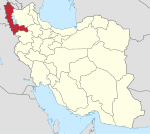Beradust Rural District
In this article, we will delve into the fascinating world of Beradust Rural District, exploring its different facets and meanings. From its origin to its relevance today, Beradust Rural District has been an object of interest and study for various disciplines. Throughout history, Beradust Rural District has sparked curiosity and debate among experts and fans, generating a wide spectrum of opinions and theories. Through this article, we will seek to shed light on Beradust Rural District and analyze its impact on society, culture and everyday life. This fascinating topic invites us to reflect and question our perceptions, presenting an enriching and diverse panorama that deserves to be explored carefully.
Beradust Rural District
Persian: دهستان برادوست | |
|---|---|
| Coordinates: 37°44′05″N 44°43′23″E / 37.73472°N 44.72306°E[1] | |
| Country | Iran |
| Province | West Azerbaijan |
| County | Urmia |
| District | Sumay-ye Beradust |
| Capital | Ravand-e Sofla |
| Population (2016)[2] | |
• Total | 11,361 |
| Time zone | UTC+3:30 (IRST) |
Beradust Rural District (Persian: دهستان برادوست)[3] is in Sumay-ye Beradust District of Urmia County, West Azerbaijan province, Iran.[4] Its capital is the village of Ravand-e Sofla.[5]
Demographics
Population
At the time of the 2006 National Census, the rural district's population was 13,766 in 2,378 households.[6] There were 11,593 inhabitants in 2,518 households at the following census of 2011.[7] The 2016 census measured the population of the rural district as 11,361 in 2,496 households. The most populous of its 55 villages was Gangachin, with 2,488 people. The district is populated by Kurds and Azerbaijani Turks.[2]
See also
References
- ^ OpenStreetMap contributors (28 September 2024). "Beradust Rural District (Urmia County)" (Map). OpenStreetMap (in Persian). Retrieved 28 September 2024.
- ^ a b Census of the Islamic Republic of Iran, 1395 (2016): West Azerbaijan Province. amar.org.ir (Report) (in Persian). The Statistical Center of Iran. Archived from the original (Excel) on 30 August 2022. Retrieved 19 December 2022.
- ^ "INCSGN Search". Iranian National Committee for Standardization of Geographical Names (in Persian). Tehran: National Cartographic Center of Iran. Archived from the original on 2 May 2019.
- ^ Habibi, Hassan (c. 2023) . Approval of the organization and chain of citizenship of the elements and units of the national divisions of West Azerbaijan province, centered in the city of Urmia. lamtakam.com (Report) (in Persian). Ministry of the Interior, Defense Political Commission of the Government Council. Notification 82808/T137. Archived from the original on 20 December 2023. Retrieved 20 December 2023 – via Lam ta Kam.
- ^ Mousavi, Mirhossein (c. 2012) . Creation and formation of 20 rural districts including villages, farms and places in Urmia County under West Azerbaijan province. rc.majlis.ir (Report) (in Persian). Ministry of the Interior, Board of Ministers. Proposal 1.5.53.11395; Notification 114206/T769. Archived from the original on 23 April 2012. Retrieved 14 December 2023 – via Islamic Parliament Research Center.
- ^ Census of the Islamic Republic of Iran, 1385 (2006): West Azerbaijan Province. amar.org.ir (Report) (in Persian). The Statistical Center of Iran. Archived from the original (Excel) on 20 September 2011. Retrieved 25 September 2022.
- ^ Census of the Islamic Republic of Iran, 1390 (2011): West Azerbaijan Province. irandataportal.syr.edu (Report) (in Persian). The Statistical Center of Iran. Archived from the original (Excel) on 20 January 2023. Retrieved 19 December 2022 – via Iran Data Portal, Syracuse University.

